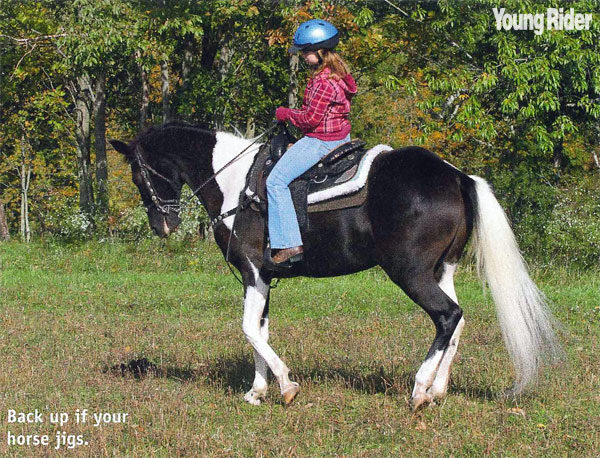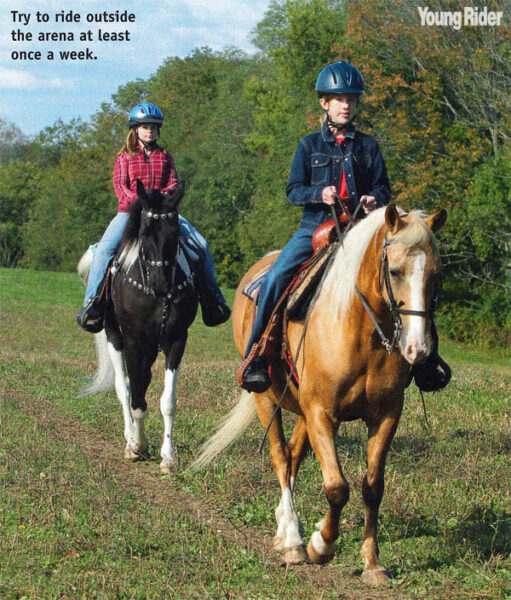If you spend a lot of time in the arena with your horse, it’s a good idea to hit the trails once in a while. Both you and your horse can get pretty bored doing the same things over and over in the arena, and trail riding makes a nice change. Some horses get “ring sour,” and act grumpy and misbehave if they’re ridden in the arena too much. Is your horse ring sour?
If you don’t have trails near your barn, find out if there’s a local park where you can trailer your horse to ride. If you don’t have a trailer, make friends with someone at the barn who does and hitch a ride. Make the effort to get out of the arena.
Trail riding is definitely not the same as riding in the arena. There’s no fence to keep you safe. If your horse isn’t used to trail riding, he may be more hyper out in the open and he may spook a lot. If your horse isn’t 100 percent perfect on your first few rides into the outside world, don’t give up. Keep on trail riding and he should get used to being ridden in the open.
Here are a few things to do to ensure that your first few trail rides go smoothly and you and your horse stay safe.
Trail Practice
If you’ve never trail ridden your horse, start out by riding him in a big field. Warm him up in the arena, to get rid of excess energy and then head out into an empty field on your farm. Make sure the barn manager or a parent knows where you are. If you have a friend at the barn who rides a quiet horse, invite her along.
You must to be able to walk, jog and lope around the field before you go on a trail ride. If your horse bolts or bucks with you, it’s time to go back in the arena and work him some more. You may find that when you ride out in the open, you need to use a stronger bit on your horse. If you have problems slowing down your horse, talk to your trainer or an experienced horse person to find out what kind of bit he or she recommends. Most of the time out on trail you’ll ride with a loose rein, so the stronger bit will only be used when you need it for control at faster speeds.
Safety Suggestions
Ride in a small group when you go on your first few trail rides. Heading out with 30 people from the local saddle club will be overwhelming for your inexperienced trail horse. Ride with a friend or experienced adult rider who has a quiet horse. Your barn pal should understand that your horse isn’t trail broke and will be patient if you have to school him. Let your barn manager and your parents know where you will be riding and how long you think you’ll be out on the trail.
If your horse tends to be hot, lunge him for a few minutes before you hop on and school him for a few minutes before you set out on the trail.
Make sure your girth is secure and your stirrups are the correct length, and strap on a helmet.
Always take a cell phone with you. Attach it to you—not the horse. If he dumps you and runs off, a cell phone attached to the saddle isn’t going to help you!
Start Off Slow
Stick to the walk for the first two or three trail rides with your inexperienced horse. Consider these rides schooling sessions and make sure your horse is listening to you. Ride on a fairly loose rein, but make sure you can pick up the reins quickly to turn or stop him right away. Try your best to stay relaxed so your horse will follow your lead. If you feel nervous, breathe deeply and chat with the other riders.
Switch places with the other riders during the ride. Your horse must learn how to go ahead of, behind and next to other horses while trail riding. If the other horses are friendly, let him walk closely to them. Sometimes horses get close on trail rides and your horse should get used to bumping into other horses.
Spooktastic!
All horses spook occasionally, so be prepared for a spook or two. But, if your horse is spooking at everything on the trail, he’s not listening to you and you need to spend a few minutes getting his attention by schooling him in a small circle. Don’t whack him with a whip or lose your temper—this won’t help spooking; it will only make him more fearful or naughty.
Simply shorten your reins, put your legs on his sides and ask him to walk in a small circle for a few minutes until he starts to listen to you again. Turn his head slightly into the center of the circle. When he flexes and stops pulling against you, you can release the pressure on the inside rein and ask him to change direction. When he calms down and behaves, set off on the trail again. Repeat this exercise every time he spooks.
Of course, if your horse spooks at something really scary (something that surprised you too–for example a deer or a cyclist) don’t be too tough on him. Breathe deeply to calm down, give him a pat on the neck and walk forward.

Jig-Free Zone
If your horse starts “jigging,” jogging when you want him to walk, ask him to halt with both reins and back him up a few strides. Ask him to halt, and then walk forward again. It’s important to nip jigging in the bud the instant it starts. Repeat this exercise every time your horse jigs until he learns it’s just easier on everyone if he just walks!
Always Walk Home
It’s really annoying when a horse begins jigging and wants to run back to the barn. This is why, starting with your very first trail ride, you must always walk back to the barn. Start walking about 10 minutes away from the barn, so your horse learns that he can’t rush back at top speed. Walking the last half mile or so will also let your horse cool down a bit and relax.
This article originally appeared in the January/February 2012 issue of Young Rider. Click here to subscribe!



